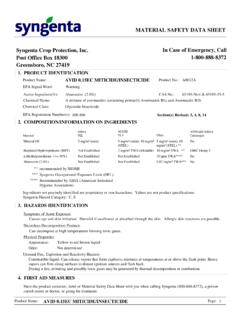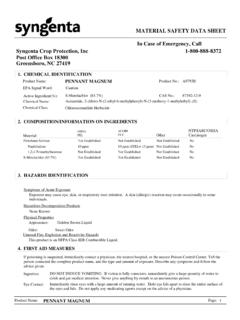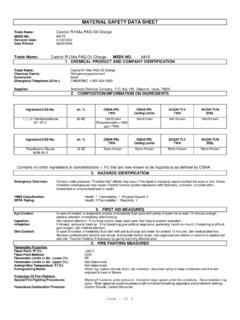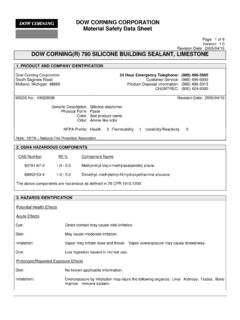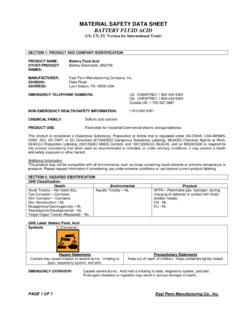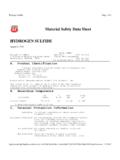Transcription of MATERIAL SAFETY DATA SHEET Syngenta Crop Protection, …
1 MATERIAL SAFETY data SHEET 1. PRODUCT IDENTIFICATION 3. COMPOSITION/INFORMATION ON INGREDIENTS 2. HAZARDS IDENTIFICATIONP roduct No.:A12839 AEPA Signal Word:WarningHealth and EnvironmentalMay form flammable dust-air if swallowed or inhaled. Causes eye irritation. May cause an allergic skin cause temporary itching, tingling, burning or numbness of exposed skin, called paresthesia. Hazardous Decomposition ProductsNone PropertiesAppearance:Off-white powderOdor:Slightly aromaticUnusual Fire, Explosion and Reactivity HazardsThis product is a combustible powder and like all combustible powders can ignite, burn and form explosive mixtures with air if not handled correctly. Mixtures of powder in air with flammable solvent vapors should be product has a minimum ignition energy between 30 and 100 millijoules. Mechanical sparks, open flames, and certain hot surfaces can serve as ignition sources for this MATERIAL .
2 Eliminate the presence of mechanical sparks and other ignition sources where dust clouds of this MATERIAL could a fire, irritating and possibly toxic gases may be generated by thermal decomposition or Name:DEMON WPEPA Registration Number(s):100-990; 100-1000 Section(s) Revised: 2, 5, 16 Syngenta Crop Protection, Office Box 18300In Case of Emergency, Call1-800-888-8372 Greensboro, NC 27419 CAS No.:52315-07-8 Chemical Name:a-cyano-(3-phenoxyphenyl)methyl-cis , trans-3-(2,2-dichloroethenyl)-2,2-dimeth ylcyclopropanecarboxylateChemical Class:A pyrethroid insecticideActive Ingredient(%):Cypermethrin ( )MaterialNTP/IARC/OSHA CarcinogenOtherOSHAPELACGIHTLVIARC Group 3 Amorphous Silica 80 mg/m /%SiO2 TWA (total dust)Not EstablishedNot Established NoCalcium Silicate 15 mg/m TWA (total); 5 mg/m TWA (respirable)10 mg/m TWA (irritation)10 mg/m TWA (total); 5 mg/m TWA (respirable) **NoCypermethrin ( )Not EstablishedNot mg/m TWA **recommended by NIOSHPage:1 Product Name:DEMON WPUpper: Not ApplicableLower: Not Applicable 4.
3 FIRST AID MEASURES 5. FIRE FIGHTING MEASURESHave the product container, label or MATERIAL SAFETY data SHEET with you when calling Syngenta (800-888-8372), a poison contol center or doctor, or going for swallowed: Call Syngenta (800-888-8372), a poison control center or doctor immediately for treatment advice. Have the person sip a glass of water if able to swallow. Do not induce vomiting unless told to do so after calling 800-888-8372 or by a poison control center or doctor. Do not give anything by mouth to an unconscious in eyes: Hold eye open and rinse slowly and gently with water for 15-20 minutes. Remove contact lenses, if present, after 5 minutes, then continue rinsing eye. Call Syngenta (800-888-8372), a poison control center or doctor for treatment on skin or clothing: Take off contaminated clothing. Rinse skin immediately with plenty of water for 15-20 minutes. Call Syngenta (800-888-8372), a poison control center or doctor for treatment inhaled: Move person to fresh air.
4 If person is not breathing, call 911 or an ambulance, then give artificial respiration, preferably mouth-to-mouth if possible. Call Syngenta (800-888-8372), a poison control center or doctor for further treatment to PhysicianMedical Condition Likely to be Aggravated by ExposureNone and ExplosionUnusual Fire, Explosion and Reactivity HazardsThis product is a combustible powder and like all combustible powders can ignite, burn and form explosive mixtures with air if not handled correctly. Mixtures of powder in air with flammable solvent vapors should be product has a minimum ignition energy between 30 and 100 millijoules. Mechanical sparks, open flames, and certain hot surfaces can serve as ignition sources for this MATERIAL . Eliminate the presence of mechanical sparks and other ignition sources where dust clouds of this MATERIAL could a fire, irritating and possibly toxic gases may be generated by thermal decomposition or Case of FireUse appropriate extinguishing media for combustibles in the area.
5 Wear full protective clothing and self-contained breathing apparatus. Evacuate nonessential personnel from the area to prevent human exposure to fire, smoke, fumes or products of combustion. Prevent use of contaminated buildings, area, and equipment until decontaminated. Water runoff can cause environmental damage. If water is used to fight fire, dike and collect :Not ApplicableNot ApplicableNot AvailableFlash Point (Test Method):Flammable Limits (% in Air):Autoignition Temperature:Ingestion:Eye Contact:Skin Contact:Inhalation:Ingredients not precisely identified are proprietary or non-hazardous. Values are not product specifications. Syngenta Hazard Category: C, SThere is no specific antidote if this product is suffering a temporary allergic reaction may respond to treatment with antihistamines or steroid creams and/or systemic contact paresthesia effects (itching, tingling, burning or numbness) are transient, lasting up to 24 hours.
6 Treat symptomatically.** Syngenta Occupational Exposure Limit (OEL)Page:2 Product Name:DEMON WP 6. ACCIDENTAL RELEASE MEASURES 7. HANDLING AND STORAGEIn Case of Spill or LeakThis product is not considered electrically conductive at low relative this MATERIAL only in electrically conductive equipment. Electrically ground and bond this equipment as well as any worker who could contact a dust cloud formed of this MATERIAL . Eliminate the presence of mechanical sparks and other ignition sources where dust clouds of this MATERIAL could form. Bulk bags (FIBC) used to contain this MATERIAL should be either type B or type C. If type C bags are used make sure they are electrically grounded before powder is discharged from the the MATERIAL in a well-ventilated, secure area out of reach of children and domestic animals. Do not store food, beverages or tobacco products in the storage area. Prevent eating, drinking, tobacco use, and cosmetic application in areas where there is a potential for exposure to the MATERIAL .
7 Wash thoroughly with soap and water after the spill at its source. Contain the spill to prevent from spreading or contaminating soil or from entering sewage and drainage systems or any body of water. Clean up spills immediately, observing precautions outlined in Section 8. Sweep up MATERIAL and place in a compatible disposal container. Scrub area with hard water detergent ( commercial products such as Tide, Joy, Spic and Span). Pick up wash liquid with additional absorbent and place into compatible disposal container. Once all MATERIAL is cleaned up and placed in a disposal container, seal container and arrange for disposition. 9. PHYSICAL AND CHEMICAL PROPERTIESOff-white powderSlightly aromaticMelting Point:Boiling Point:Specific Gravity/Density:Not AvailableNot ApplicableNot AvailableAppearance:Odor: Solubility in H2O 8. EXPOSURE CONTROLS/PERSONAL PROTECTIONP revent eating, drinking, tobacco usage and cosmetic application in areas where there is a potential for exposure to the MATERIAL .
8 Wash thoroughly with soap and water after eye contact is likely, use dust-proof chemical goggles. Facilities storing or utilizing this MATERIAL should be equipped with an eyewash facility and a SAFETY contact is likely, wear chemical-resistant gloves (such as barrier laminate, butyl rubber, nitrile rubber, neoprene rubber, natural rubber, polyethylene, polyvinyl chloride [PVC] or Viton), coveralls, socks and chemical-resistant footwear. Stringent housekeeping measures are necessary to prevent translocation of the MATERIAL from contaminated work surfaces to uncontaminated surfaces (railings, doors, etc.). Unprotected contact with such translocated MATERIAL can result in paresthesia effects (see Section 11).A particulate filter respirator may be necessary until effective engineering controls are installed to comply with occupational exposure limits. Use a NIOSH approved respirator with any HE filter.
9 Use a self-contained breathing apparatus in cases of emergency spills, when exposure levels are unknown, or under any circumstances where air-purifying respirators may not provide adequate breathing air from drum headspace. Hydrogen cyanide gas may be released during opening and dispensing, and in case of spills. Use local exhaust ventilation or air-supplied respiratory protection to keep exposures below the TLV Ceiling :Eye Contact:Skin Contact:Inhalation:THE FOLLOWING RECOMMENDATIONS FOR EXPOSURE CONTROLS/PERSONAL PROTECTION ARE INTENDED FOR THE MANUFACTURE, FORMULATION AND PACKAGING OF THIS PRODUCT. FOR COMMERCIAL APPLICATIONS AND/OR ON-FARM APPLICATIONS CONSULT THE PRODUCT :3 Product Name:DEMON WP 11. TOXICOLOGICAL INFORMATIONA cute Toxicity/Irritation Studies (Finished Product)Reproductive/Developmental EffectsChronic/Subchronic Toxicity StudiesCarcinogenicityToxicity of Other ComponentsIngestion:Dermal:Inhalation:Ey e Contact:Skin Contact:Skin Sensitization:Oral (LD50 Rat) : Moderately Irritating (Rabbit)Not AvailableA skin sensitizer in animal (LD50 Rabbit) : Inhalation (Not available at this time.)
10 : 1800 mg/kg body weight 2000 mg/kg body weight Target OrgansOther Toxicity InformationIn humans, contact with exposed skin may result in temporary itching, tingling, burning or numbness, called paresthesia. The effect may result from splash, aerosol, or hot vapor contact, or transfer to the face from contaminated gloves and hands. The symptoms normally disappear within 24 hours. Face and genital areas are especially susceptible to this effect. Paresthesia involving the face is also known as "subjective facial sensation" or SFS. Active Ingredients 10. STABILITY AND REACTIVITYS tability:Stable under normal use and storage Polymerization:Will not to Avoid:None PressureHazardous Decomposition Products:Materials to Avoid:Oxidizing : There were no cypermethrin-induced effects in fertility in two separate two-litter three (filial) generation studies in the : NOEL (2-yr) for dogs 5 mg/kg, rats system effects typical of pyrethroids (motor incoordination, gait abnormalities) in a range of repeated dose studies (dog and rat).


